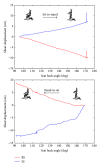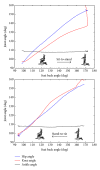Sliding and lower limb mechanics during sit-stand-sit transitions with a standing wheelchair
- PMID: 25105120
- PMCID: PMC4109664
- DOI: 10.1155/2014/236486
Sliding and lower limb mechanics during sit-stand-sit transitions with a standing wheelchair
Abstract
Purpose: This study aimed to investigate the shear displacement between the body and backrest/seat, range of motion (ROM), and force acting on the lower limb joints during sit-stand-sit transitions by operating an electric-powered standing wheelchair.
Methods and materials: The amounts of sliding along the backrest and the seat plane, ROM of lower limb joints, and force acting on the knee/foot were measured in twenty-four people with paraplegia.
Results: Without an antishear mechanism, the shear displacement was approximately 9 cm between the user's body and the backrest/seat surfaces. During standing up, the user's back slid down and the thigh was displaced rearward, but they moved in opposite directions when wheelchair sat back down. A minimum of 60 degrees of ROM at the hip and knee was needed during sit-stand-sit transitions. The maximal resultant forces acting on the knee restraints could reach 23.5% of body weight.
Conclusion: Sliding between the body and backrest/seat occurred while transitioning from sitting to standing and vice versa. A certain amount of ROM at lower limb joints and force acting on the knee was necessitated during sit-stand-sit transitions. Careful consideration needs to be given to who the user of the electric powered standing wheelchair is.
Figures




Similar articles
-
Sit-stand and stand-sit transitions in older adults and patients with Parkinson's disease: event detection based on motion sensors versus force plates.J Neuroeng Rehabil. 2012 Oct 7;9:75. doi: 10.1186/1743-0003-9-75. J Neuroeng Rehabil. 2012. PMID: 23039219 Free PMC article.
-
Stand-to-sit kinematic changes during pregnancy correspond with reduced sagittal plane hip motion.Clin Biomech (Bristol). 2019 Jul;67:107-114. doi: 10.1016/j.clinbiomech.2019.05.014. Epub 2019 May 9. Clin Biomech (Bristol). 2019. PMID: 31100701
-
Improved Weight-Bearing Symmetry for Transfemoral Amputees During Standing Up and Sitting Down With a Powered Knee-Ankle Prosthesis.Arch Phys Med Rehabil. 2016 Jul;97(7):1100-6. doi: 10.1016/j.apmr.2015.11.006. Epub 2015 Dec 11. Arch Phys Med Rehabil. 2016. PMID: 26686876
-
The Sit & Stand chair. A revolutionary advance in adaptive seating systems.J Long Term Eff Med Implants. 2004;14(6):535-43. doi: 10.1615/jlongtermeffmedimplants.v14.i6.80. J Long Term Eff Med Implants. 2004. PMID: 15698379 Review.
-
Kinematic Characteristics of Sit-to-Stand Movements in Patients With Low Back Pain: A Systematic Review.J Manipulative Physiol Ther. 2019 Sep;42(7):532-540. doi: 10.1016/j.jmpt.2018.12.004. J Manipulative Physiol Ther. 2019. PMID: 31864436
References
-
- Arva J, Paleg G, Lange M, et al. RESNA position on the application of wheelchair standing devices. Assistive Technology. 2009;21(3):161–171. - PubMed
-
- Baker K, Cassidy E, Rone-Adams S. Therapeutic standing for people with multiple sclerosis: efficacy and feasibility. International Journal of Therapy and Rehabilitation. 2007;14(3):104–109.
-
- Walter JS, Sola PG, Sacks J, Lucero Y, Langbein E, Weaver F. Indications for a home standing program for individuals with spinal cord injury. The Journal of Spinal Cord Medicine. 1999;22(3):152–158. - PubMed
Publication types
MeSH terms
LinkOut - more resources
Full Text Sources
Other Literature Sources
Medical
Research Materials

